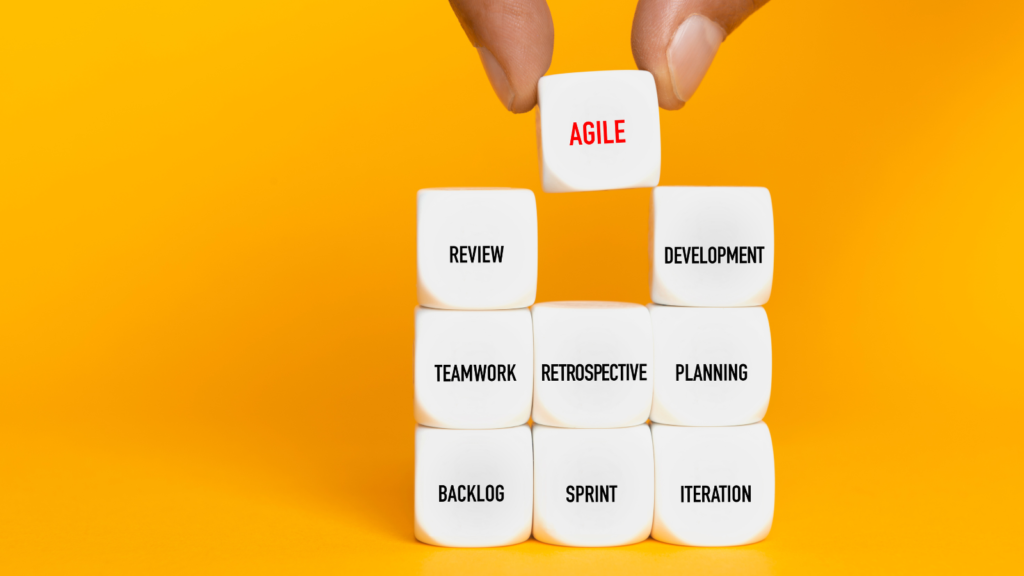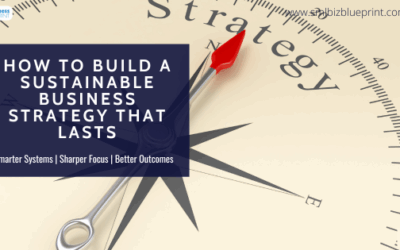In a rapidly evolving market, the ability to adapt quickly and efficiently isn’t just an advantage; it’s a necessity for survival and success.
As organisations face unprecedented changes and challenges, those equipped with agile methodologies stand out, consistently outperforming their competitors and securing a profitable future.
This post delves into what it means to be an agile business and why it has become a cornerstone of modern corporate strategy.
From enhancing operational efficiency to fostering innovation and ensuring long-term sustainability, agility offers a pathway to survive and thrive in today’s dynamic economic landscape.
We’ll explore fundamental agile principles, practical methodologies like Scrum and Kanban, and real-world examples of businesses that have reaped substantial benefits from their agile transformations.
Whether you’re a startup looking to embed agility from the ground up or an established enterprise aiming to revamp your processes, this comprehensive guide will provide valuable insights into making agility a core component of your business strategy.
Let’s dive into how embracing agile business practices can elevate your company’s profitability and ensure its sustainable future.

#1 Understanding Business Agility: A Key to Modern Success
In an era marked by rapid technological advancements and shifting market demands, business agility has become essential for organisations aiming to remain competitive and relevant.
But what exactly does it mean for a business to be agile?
Business agility refers to an organisation’s ability to adapt quickly to market changes, integrate feedback with minimal disruption, and continuously refine its operations and processes.
This adaptability helps companies manage and implement change effectively and capitalise on opportunities more swiftly than their competitors.
At its core, agility fosters a culture that values flexibility, responsiveness, and proactive learning.
Here are the key characteristics that define an agile business:
Rapid Decision-Making
Agile businesses empower their teams to make decisions quickly and effectively, reducing the time from ideation to execution.
Flexibility in Processes
Agile companies adopt a flexible approach that allows them to respond dynamically to industry and market changes instead of rigid workflows.
Continuous Improvement
Regular feedback loops with stakeholders, including customers and team members, drive continual growth and improvement.
Resilience
Being resilient, especially when facing disruptions or failures, is crucial for agile businesses to bounce back stronger and be more informed.
Why is this approach so critical today?
Unexpected opportunities and obstacles punctuate the modern business landscape. Traditional methods that prioritise long-term planning and fixed strategies no longer suffice.
For instance, during the global health crisis, companies with agile practices could pivot their strategies quickly, like shifting to digital platforms or modifying supply chains, which proved pivotal in sustaining operations.
Incorporating agility into a business isn’t just about adopting new tools or methodologies; it’s about creating a mindset that embraces change and uncertainty as avenues for innovation and growth.
As we explore further in this post, adopting these agile practices enhances operational efficiency and builds a sustainable foundation for the future.
By fostering an agile culture, businesses can not only navigate the complexities of today’s economic environment but also pave the way for future success, ensuring they remain ahead of the curve in a constantly evolving marketplace.
#2 The Profitable Edge: How Agility Enhances Business Performance
Adopting agile practices is more than a strategic choice; it’s a transformative shift that enhances a company’s profitability through increased operational efficiency and improved responsiveness to market conditions.
This section explores how agility directly contributes to a business’s financial health and competitive edge.
Increased Operational Efficiency
At the heart of agility is maximising value by minimising waste—whether in time, resources, or effort. Agile businesses achieve this by streamlining processes and removing bottlenecks that slow down operations.
For example, teams can visualise their workflows and identify areas for improvement by using Scrum or Kanban boards, leading to faster turnaround times and reduced costs.
Faster Response to Market Changes
In today’s fast-paced business environment, the ability to react quickly to market changes is invaluable. Agile organisations use iterative development and continuous feedback loops to refine their products and services in alignment with customer needs and preferences.
This adaptability can be a significant profit driver, allowing businesses to stay relevant and competitive and capture market share from slower-moving competitors.
A study published by the Harvard Business Review highlighted that agile firms could achieve revenue growth up to 37% faster and generate 30% higher profits than non-agile companies.
Enhanced Customer Satisfaction
Agility also enhances customer satisfaction, which drives sales. By adopting customer-focused approaches like design thinking, agile businesses can develop products and services that meet customer demands.
Satisfied customers are more likely to become repeat buyers and brand advocates, increasing each customer’s lifetime value and reducing customer acquisition costs.
Risk Management
Agile practices equip businesses to manage risks more effectively by allowing them to respond to changes without being bound by detailed long-term plans. This flexibility can be particularly crucial in industries facing high volatility or rapid technological changes.
By adopting an incremental approach to product development and decision-making, companies can reduce the scope of failure and mitigate potential losses.
The profitability benefits of agility are clear and quantifiable. By implementing agile practices, businesses enhance their operational efficiencies and customer responsiveness and create a robust framework for managing risks and adapting to the unexpected.
This dynamic capability is essential for any company aiming to thrive in today’s unpredictable business landscape and secure a profitable future.
#3 Sustainability Through Agility: Long-Term Benefits for Businesses
In an ever-evolving global marketplace, sustainability is increasingly becoming a cornerstone of long-term business success.
Agile practices are not only about enhancing immediate profitability; they also play a pivotal role in ensuring that a business remains viable and competitive over time.
This section delves into how agility contributes to sustainability in various industries, reinforcing why it’s indispensable for future-proofing businesses.
Adaptability to Market Dynamics
Agile businesses thrive on change. They can quickly pivot strategies in response to shifting market conditions, regulatory changes, or new customer demands. This level of adaptability is crucial for long-term survival, as it allows businesses to align with external pressures and opportunities continuously.
For instance, agile companies can more effectively adjust their offerings and operations during economic downturns to maintain relevance and customer engagement, thus sustaining operations through challenging periods.
Resource Efficiency
One of the hallmarks of agile practices is the efficient use of resources. By employing techniques such as Lean management, businesses can minimise waste in all forms—material, human, and operational—leading to more sustainable practices.
This reduces costs and lessens environmental impact, an increasingly important factor for customers and stakeholders who prioritise corporate responsibility.
Innovation and Continuous Improvement
Agility fosters an environment where innovation is encouraged, and failure is seen as a learning opportunity. This continuous cycle of testing, feedback, and improvement drives businesses to develop new solutions that meet evolving customer needs and environmental standards, promoting sustainability.
A practical example is seen in technology firms that employ agile methodologies to roll out new software updates that improve user experience and efficiency while reducing the ecological footprint of their operations.
Employee Engagement and Retention
Agile environments value team collaboration and individual contributions, which boosts employee morale and retention. Engaged employees are more productive and committed to the company’s success, which is essential for sustaining performance over the long term.
Moreover, high retention rates reduce the costs and disruptions associated with frequent hiring and training new staff.
Building Resilience
Finally, agility enhances a business’s resilience against disruptions. Agile companies can quickly adapt their supply chains, modify their business models, or shift to digital operations, as many did during the COVID-19 pandemic.
This ability to respond and adapt safeguards the business against immediate threats and builds a robust foundation for enduring success.
In conclusion, integrating agile practices into business operations goes beyond immediate financial gains—it ensures that companies remain sustainable and resilient in a dynamic world.
By fostering adaptability, efficiency, continuous improvement, and resilience, agility secures a path to long-term prosperity.

#4 Agile Methodologies Unveiled: Scrum, Kanban, and Lean Startup
Agile methodologies provide the frameworks necessary for businesses to implement agility effectively. Each methodology, whether Scrum, Kanban, or Lean Startup, offers unique strategies tailored to different operational needs and industry demands.
This section outlines these popular methodologies and explains how they can be applied to foster business agility.
Scrum
Scrum is a framework that promotes collaboration, communication, and speed in complex projects. It divides work into short cycles known as sprints, typically lasting two to four weeks. This allows teams to tackle small project parts quickly and adjust as needed based on ongoing feedback and changes.
Scrum facilitates rapid iteration and testing, leading to quicker releases and the ability to adapt quickly to new market conditions.
For example, software development companies often use Scrum to manage their development processes, enabling them to launch updates faster and more frequently.
Kanban
Unlike Scrum, which is iterative, Kanban is a continuous flow methodology. It focuses on visualising the workflow on a kanban board—usually a physical or digital board with cards representing tasks.
This visualisation helps teams manage work by limiting the work in progress, reducing bottlenecks and improving throughput.
Industries like manufacturing and marketing, where tasks vary significantly in type and duration, find Kanban especially effective for managing daily operations smoothly and efficiently.
Lean Startup
The Lean Startup methodology applies agile principles to innovation in new products and businesses. It emphasises the concept of “build-measure-learn” to test hypotheses about a product and its business strategy.
By developing a minimum viable product (MVP) and iterating based on user feedback, companies can avoid building products that customers do not want and significantly reduce time and resources wasted.
This approach is crucial for startups and businesses launching new products in uncertain markets.
Each of these methodologies enhances business agility by allowing organisations to respond to changes quickly, reduce risks associated with new initiatives, and improve customer satisfaction through continuous delivery and improvement.
By implementing these agile practices, businesses can better align with their operational goals and foster an innovative and adaptive culture.
Understanding and choosing the correct agile methodology depends on the specific challenges and objectives of the business.
However, the underlying principles of transparency, inspection, and adaptation are central to ensuring that the chosen approach drives the desired outcomes in business agility.
#5 Overcoming Challenges in Agile Transformation
While the transition to agile practices offers numerous benefits, it has challenges. Companies often need help with the successful adoption of agile methodologies.
This section identifies common obstacles and provides strategies to effectively overcome them, ensuring a smooth and successful agile transformation.
Resistance to Change
One of the most significant barriers to implementing agile is many organisations’ natural resistance to change.
Employees and sometimes management can be accustomed to traditional methods and may view agile as threatening established processes.
Strategy
Fostering a culture of openness and inclusion is crucial to mitigating this resistance. Using workshops and training sessions, educate all levels of the organisation about the benefits of agile practices.
Lack of Expertise
Agile methodologies require specific skills and an understanding that may be absent in the current workforce.
Strategy
Address this gap by investing in staff training and certification programs. Hiring or consulting with agile experts can provide guidance and mentorship to nurture in-house expertise.
Scaling Agile
As organisations grow, scaling agile practices across more extensive operations and diverse teams can become complex.
Strategy
Implement scalable, agile frameworks such as SAFe (Scaled Agile Framework), which are designed to address the challenges of applying agile at scale.
These frameworks provide structured guidance on roles, responsibilities, and processes at the enterprise level.
Inadequate Tooling
Having the right tools is essential to support agile practices, especially in critical collaboration and speed environments.
Strategy
Invest in agile project management tools that facilitate collaboration, transparency, and real-time communication.
Tools like JIRA, Trello, and Asana can help manage agile projects by tracking progress and providing visibility to all team members.
Misalignment Between Business Units
Agile transformation is often limited to specific teams, like IT or development, leading to silos and misalignment with business units that do not adopt agile.
Strategy
Extend agile principles beyond IT and development teams by applying them to other business areas, such as HR, marketing, and sales.
This integrated approach ensures the entire organisation is aligned and moving towards common objectives.
Overcoming these challenges requires a thoughtful approach that considers the organisation’s unique context and needs. It involves commitment from all levels, especially leadership, to drive change and ensure that agile transformation leads to sustainable improvements.
By proactively addressing these hurdles, companies can fully realise the benefits of agility and enhance their competitive edge in the market.
#6 Technology’s Role in Enabling Business Agility
Technology plays a pivotal role in the journey towards becoming an agile business. Modern tools and digital solutions are fundamental in supporting agile practices, facilitating faster decision-making, improving collaboration, and enabling a more flexible approach to work.
This section discusses how technology can enhance business agility and the types of tools that can make a significant impact.
Streamlining Communication
Agile methodologies thrive on quick feedback loops and continuous communication. Tools like Slack, Microsoft Teams, and Zoom facilitate instant communication and regular check-ins, which are essential for maintaining the pace and adaptability agile practices demand.
Key Advantage
These platforms allow for seamless collaboration across departments and geographical locations, ensuring that team members remain connected and informed, irrespective of their physical presence.
Enhancing Project Management
Agile project management tools such as JIRA, Trello, and Asana help organise tasks by allowing teams to track progress, prioritise work, and adapt to changes in real-time.
Key Advantage
These tools provide visibility into project timelines, deliverable statuses, and team activities, making it easier to manage complex projects and ensuring all members are aligned with the project goals.
Facilitating Continuous Integration and Deployment
Continuous integration (CI) and continuous deployment (CD) in software development embody the agile philosophy. Tools like Jenkins, GitLab, and CircleCI automate code testing and deployment, accelerating the development process and minimising errors.
Key Advantage
CI/CD tools enhance product quality and speed up the release cycle, allowing businesses to respond rapidly to market demands and customer feedback.
Leveraging Data Analytics
Real-time data analytics tools such as Google Analytics, Tableau, and Power BI provide insights into customer behaviour, market trends, and operational efficiency. This information is crucial for making informed decisions quickly.
Key Advantage
With access to real-time data, businesses can promptly pivot strategies, identify areas for improvement, and optimise operations to better meet customer needs and market conditions.
Supporting Remote Work
Cloud technologies like Google Cloud, AWS, and Microsoft Azure enable teams to access necessary data and systems from anywhere. This facilitates remote work and ensures that business operations continue uninterrupted regardless of physical location constraints.
Key Advantage
Cloud solutions support the logistical aspects of remote work and enhance security and scalability, which are critical for businesses aiming to remain agile in a volatile market environment.
Integrating these technologies into business operations can significantly boost an organisation’s agility.
By embracing digital tools, companies streamline their processes and build a foundation that supports rapid adaptation and continuous improvement—critical attributes of a successful agile business.

#7 Agility In Practice
To truly understand the impact of agile business practices, it’s insightful to explore real-world examples of companies that have successfully embraced agility.
This section highlights case studies from various industries, showcasing how agile methodologies have driven profitability and sustainability, demonstrating the practical benefits and transformative potential of agility in business.
Tech Industry: Spotify’s Agile Model
Global streaming giant Spotify has long been celebrated for its innovative approach to agile practices. The company organises its engineering teams into squads, tribes, chapters, and guilds, which promotes a high degree of autonomy and encourages innovation.
This structure allows Spotify to experiment and iterate rapidly, enabling it to stay ahead in the highly competitive music streaming industry.
Key Takeaway
Spotify’s ability to quickly adapt to user preferences and market changes has been crucial in its growth and dominance in the streaming space.
Manufacturing Sector: Toyota’s Lean Production
Toyota implemented the Lean manufacturing approach, a pillar of agile methodology, to optimise production efficiency and quality. This system focuses on continuous improvement (Kaizen), respect for people, and standard work practices, enhancing responsiveness and flexibility in operations.
Key Takeaway
Toyota’s implementation of Lean principles has reduced waste, improved operational efficiency, and ensured the company could quickly adapt to supply chain disruptions and changes in consumer demand.
Financial Services: ING’s Agile Transformation
ING, a multinational banking corporation, adopted an agile way of working by restructuring its entire organisation around agile principles. This shift involved forming self-managing teams, which led to faster decision-making, improved customer service, and increased employee satisfaction.
Key Takeaway
ING’s agile transformation enhanced flexibility and responsiveness to customer needs, setting new standards in the banking industry for innovation and customer service.
Retail: Nike’s Digital Transformation
Nike’s focus on digital agility illustrates the power of agile practices in the retail sector. By leveraging digital tools and agile methodologies, Nike has significantly enhanced its online presence and direct-to-consumer sales channels, enabling it to adapt quickly to the fast-changing retail landscape.
Key Takeaway
Nike’s agile approach to digital commerce has allowed for a more responsive customer experience and faster adaptation to market trends, boosting its sales and brand strength.
These case studies underscore the versatility and effectiveness of agile practices across different sectors. Each company’s success story provides actionable insights and inspiration for businesses aiming to embark on their agile transformations.
By examining these examples, organisations can better understand the potential impacts of agility on their operations and strategic goals, thereby motivating a more comprehensive adoption of agile methodologies.
Conclusion
As explored throughout this post, embracing agile business practices offers more than a methodological shift—it signifies a transformative movement towards enhanced profitability, sustainability, and market responsiveness.
From increased operational efficiency and customer satisfaction to the flexibility in managing change and fostering innovation, agility equips businesses with the necessary tools to thrive in today’s dynamic economic landscape.
Key Takeaways:
Agile methodologies, such as Scrum, Kanban, and Lean Startup, provide frameworks that help businesses adapt quickly, reduce waste, and continuously improve.
Adopting agile practices can present substantial challenges—from cultural resistance to scaling issues—but they are not insurmountable. Strategic planning, education, and the right tools can effectively manage these challenges.
Technology enables agility, offers solutions that enhance communication, streamlines project management, and provides crucial data insights that guide decision-making.
Real-world examples from companies like Spotify, Toyota, ING, and Nike demonstrate the significant benefits of agile transformations across various industries.
As the business world evolves, the need for agility will grow stronger. Companies that invest in agile practices now will be better positioned to navigate future challenges and capitalise on new opportunities.
Whether you are a startup entrepreneur or a leader in an established corporation, the time to act is now. Transforming your business to be more agile is not just an option—it is necessary for success in the modern world.
Reflect on the agile practices discussed in this post and consider how they can be integrated into your business operations. Start small by introducing a single agile methodology or tool, and scale up as you see the benefits.
Please share your experiences and challenges with us in the comments below.
Together, let’s build businesses geared for today’s challenges and tomorrow’s opportunities.
FAQ
Q1. What is business agility, and why is it important?
A2: Business agility refers to a company’s ability to adapt quickly to market changes, efficiently integrate feedback, and continually improve its operations. It is essential because it helps businesses remain competitive and responsive in a rapidly changing economic environment, thus driving profitability and sustainability.
Q2. How does agile methodology improve profitability?
A2: Agile methodologies improve profitability by enhancing operational efficiency, reducing waste, and enabling businesses to respond quickly to customer needs and market changes. This leads to higher customer satisfaction, improved product development, and increased revenue.
Q3. Can agile practices be applied to industries outside of technology?
A3: Yes, agile practices can be applied across various industries, including manufacturing, banking, healthcare, and retail. The principles of agility—such as flexibility, rapid iteration, and continuous improvement—are universal and can enhance operations in any business context.
Q4. What are some common challenges businesses face when adopting agile practices?
A4: Common challenges include resistance to change from employees, lack of agile expertise, difficulties in scaling agile practices, and misalignment between different business units. Overcoming these challenges typically involves comprehensive training, clear communication of benefits, and sometimes restructuring teams or processes.
Q5. What role does technology play in supporting agile practices?
A5: Technology supports agile practices by providing tools for better communication, project management, and data analysis. For example, project management software helps teams track progress and adapt to changes quickly, while data analytics tools provide insights that inform decision-making in real time.
Q6. Are there any real-world examples of successful agile transformations?
A6: Numerous companies have successfully implemented agile transformations, including Spotify with its innovative team structures, Toyota with its Lean manufacturing processes, ING with its agile banking operations, and Nike’s digital retail strategies. These examples highlight the versatility and effectiveness of agile methodologies across different sectors.
Q7. How can a company start its transition towards becoming more agile?
A7: A company can start its agile transition by educating its leadership and workforce about the principles and benefits of agility. It can adopt a specific agile methodology that aligns with its operations and gradually expand agile practices across the organisation. Regular training sessions, pilot projects, and specialised tools can facilitate this transformation.
Other Articles
Strategies for Small Businesses to Thrive in the Digital Age




